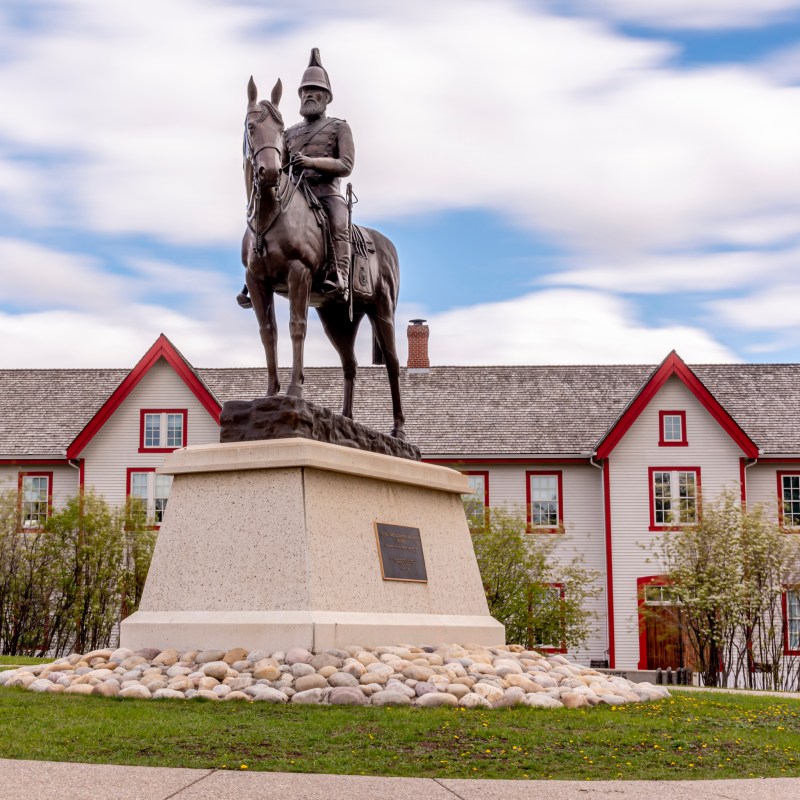
For a fascinating summer road trip across the prairies of Canada, consider the Red Coat Trail, named after the scarlet tunics of the Royal Canadian Mounted Police, originally called the North-West Mounted Police or NWMP.
Videos by TravelAwaits
This route across Manitoba, Saskatchewan, and Alberta is best taken between late spring and early fall.
The Red Coat Trail is the tribute band of historic trails. It’s often far away from the route of 1874’s Great March West.
The NWMP was created to establish law and order in the Canadian West. The provoking event was the 1873 Cypress Hills Massacre, where some American hunters killed about 20 Assiniboine people in Canada. Canada wanted to police her borders and stop the illegal whiskey trade. Calling it whiskey is generous, however. What the unscrupulous traders passed off to the indigenous people was often revolting.
On the Great March West, many horses and oxen died of hunger and cold. Fresh water was scarce. The men suffered from dysentery and pneumonia. NWMP member James Finlayson calmly described it all in his journal.
Before the Red Coat Trail’s official start in Winnipeg, visitors coming from the south can see where the historic march began.
Fort Dufferin National Historic Site
On July 8, 1873, about 300 men and their long train of oxen and horses left Fort Dufferin, now a National Historic Site. They followed (more or less) the Boundary Commission Trail.
For the modern Red Coat Trail, go to Winnipeg and take Highway 2.

Winnipeg
Winnipeg is the capital of Manitoba, reachable by air, train, or car. There are lots of things to do in Winnipeg, so spend a couple of days if you can. Exploring the historic sites and cuisine scene will set you up for a great trip.
Saint Claude
Every road trip needs its quota of giant roadside attractions, and the big pipe in Saint Claude certainly qualifies. Also here: a dairy museum, a public garden, and a striking modern-style Catholic church.
Central Manitoba Tourism lists more attractions along this stretch of the Red Coat Trail, including the quirky glass bottle house in Treherne.
Souris
The longest pedestrian suspension bridge in Canada is in the little town of Souris. Crossing the bridge will take you to a 1910 mansion, now the Hillcrest Museum.

Redvers
After leaving Manitoba, one of the first towns you’ll encounter in Saskatchewan is Redvers, with its own giant attraction: a larger-than-life, full-color statue of a red-coated NWMP on a horse.
Wauchope And The Ghost Town Trail
The almost-abandoned town of Wauchope is the start of the Ghost Town Trail, a stretch of the Red Coat Trail running to Govenlock. Wauchope is still home to a few families, a church, and a grain elevator (a fast-disappearing sight on the Canadian prairies).
Some of these ghost towns are still occupied, but others are almost completely gone, like Glasnevin. It’s surprising how quickly they disappear.
Why are there ghost towns here? The short answer is drought and the Great Depression. There are more nuanced explanations to be found on plaques and markers, in occasional church services, and in the town histories tucked away on family bookcases. Every town has a story — and people who still love it.

Roche Percee
After Wauchope, the trail continues on Highway 13 west to Weyburn.
For a side trip to a notable point on the Red Coat Trail, visit La Roche Percee Provincial Historic Site near Estevan. The rock formations here are a landmark and a sacred site.
The NWMP camped at Roche Percee and then divided into two groups. Some went northeast to Fort Ellice and took the northern route to Fort Edmonton. The main group kept going west.
Weyburn
A regional service center, Weyburn has its share of indoor and outdoor attractions. The Soo Line Historical Museum, located in a former power plant, looks like a typical pioneer-town museum, but it boasts the Charles Wilson Silver Collection. With over 5,000 individual pieces, it’s said to be the world’s largest one-man collection of silver. Wilson, a local grain farmer, spent many years putting it together. He died at 90 and bequeathed it to the museum

Gravelbourg
For a side trip to explore French culture in Saskatchewan, check out Gravelbourg, established in the early 1900s by the French-Canadian priest Father Louis Pierre Gravel. Beyond building the impressive Our Lady of Assumption Co-Cathedral, Gravel convinced many French-Canadians to settle in the region. Fransaskois culture is alive and well here.
In addition to Gravelbourg’s heritage walking tour and museum, there are local parks with campgrounds and nine-hole golf courses.
Mossbank
Like much of Saskatchewan, this region is good for birding. If you want to extend your trip, head up to the Old Wives Lake Migratory Bird Sanctuary. You’ll see Mossbank, near where the NWMP camped and where they first met the First Nations people on the Great March.
During World War II, Mossbank hosted the British Commonwealth Air Training Plan No. 2 Bombing and Gunnery School.

Grasslands National Park
Head back to the Red Coat Trail, and then another side trip beckons.
The Badlands Parkway in the East Block of Grasslands National Park is one of the newest ways to explore this peaceful expanse of protected prairie. The park is home to reintroduced Plains bison, reminders of the buffalo who used to roam the prairies by the thousands. As a Dark Sky Preserve, Grasslands is a great camping place for stargazers.
Access to the East Block is from Highway 18, south of Wood Mountain. Wood Mountain Regional Park has a monument to the famous Sioux leader Sitting Bull. In 1876, after defeating General George Armstrong Custer at the Battle of the Little Bighorn, Sitting Bull and his people came here for safety. Some of their descendants still live in the area. Wood Mountain Regional Park, Grasslands National Park, and the Fort Walsh National Historic Site all tell parts of their story.
Eastend
Eastend is a small town with at least four great things going for it in addition to the scenery. There’s the T. rex Discovery Centre for fossil and dinosaur lovers, the Wallace Stegner House for writers and other creatives, and Jack’s Cafe for real milkshakes made with ice cream and Saskatoon berry pie in season. Finally, Eastend is the beginning of the Cypress Hills.
Fort Walsh And The Cypress Hills
The Cypress Hills are a unique landform — a plateau on the prairie. Driving through Cypress Hills Interprovincial Park is best done on a dry summer day. Ask for local advice if it’s raining. This is the highest ground between the Rockies and Eastern Canada and offers some truly spectacular views.
The Cypress Hills Massacre of 1873 happened near the Fort Walsh National Historic Site. For me, Fort Walsh has always been very moving. Looking at the photos here, I finally realized just how devastating the killing of nearly all the buffalo was to the Plains people.
On the Alberta side of Cypress Hills Interprovincial Park, Elkwater has a lake, camping, and other summer recreation. If you visit Elkwater, you can rejoin the Red Coat Trail in Pakowki.

Lethbridge And Fort Whoop-Up
The NWMP’s goal in 1874 was to put Fort Whoop-Up’s whiskey traders out of business. The fort was already empty when the NWMP arrived.
Since then, the city of Lethbridge has grown up here. The reconstructed Fort Whoop-Up tells the story of the complex relationships among the people and the many changes caused by the buffalo trade. Visit the Galt Museum and Fort Whoop-Up in Lethbridge, and don’t forget to admire the High Level Bridge, the longest, highest trestle bridge in the world.
Lethbridge is a small city where you could easily spend a day or two.
Fort Macleod
The Great March ended with the NWMP hastily building a fort at what is now Fort Macleod. The original fort building didn’t last long, but there is a reconstructed version, the Fort Museum of the NWMP and First Nations Interpretive Centre.
The Head-Smashed-In Buffalo Jump, a UNESCO World Heritage site, is just a short drive away.

Calgary
The Red Coat Trail ends at Fort Macleod. From here to Calgary, the Rockies are within sight from the main highway (Highway 2).
The British Commonwealth Air Training Plan had many sites in southern Alberta, including Fort Macleod, Claresholm, and High River. Aviation fans should stop at the Bomber Command Museum of Canada to see the Lancaster Bomber.
Spend a few days in Calgary, a major city with lots to do year-round. The reconstructed Fort Calgary is another reminder of the NWMP’s historic role.
What To Know Before You Go
The Red Coat Trail is a two-lane road, slower than the Trans-Canada Highway and with fewer services and towns. The distance from Winnipeg to Calgary is about 920 miles, with numerous side-trip possibilities.
All along the way, you’ll find campgrounds, municipal and provincial parks, walking trails, and golf courses. If you have questions, just ask. The locals will be happy to help.
